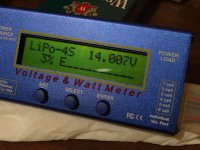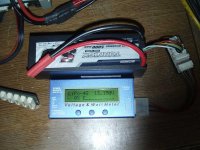I tend to map cell capacity then keep usage within the beefier areas.
I began testing by mapping mAh /100th V discharge - too time consuming and inaccurate, IMO.
Voltage graph shifted almost .1V lower than actual rest voltage.
See 4th graph ("Recycled Li-ion" - red) for direct comparison.
RC LiPo displayed a noticeably lower area of good capacity
So I decided to remap using a mAh/10thV
Tools -
MeanWell 24V bulk charger (19.8 - 29.8V adjustable)
30V 4 digit volt meter, 100ths capable
Ah meter
I discharged my 25.9V recycled Lipo pack to 24.5V.
Then precisely equalized the cells at 3.50V.
I applied charge with MW (MeanWell) set to:
25.20V (3.60V) - full charge required .27Ah
25.90V (3.70V) - full charge required .53Ah
26.60V (3.80V) - full charge required 3.87Ah
27.30V (3.90V) - full charge required 3.15Ah
28.00V (4.00V) - full charge required 4.60Ah
28.70V (4.10V) - full charge required 4.10Ah
29.40V (4.20V) - full charge required 1.85Ah
(
Ah is capacity between each .10V)
Telling, but lacking resolution.
So I mapped in 2/100thV increments. (50th V)
1st discharging to a stable 3.50V per cell
Then setting MeanWell to 2/100thV higher (3.52 etc), then charging through a mAh meter and recording mAh required to stabilize voltage at higher voltage.
Then repeating test in 2/100thV increments.
These non-RC Lipo displayed a strange capacity bulge near 4.12V, so I repeated the same test with another sample ... with very similar results.
(Rated optimal use at >3.75-4.05 to 4.15 for trips.)
Li-ion 18650 (laptop cells) look optimal with a >3.70V to 4.05V for an estimated 300% lifespan.
An alternate source displays very similar results in a more familiar graph style.
Every formulation is different and you should test you own cells.
Discharge to a stable lowest voltage you want to test.
After finding no noticeable capacity at 3.5V, I began starting my tests at 3.6V.
Results show barren and rich regions of energy capacity. At the upper (4.2V) regions 1/10thV reduction in charge voltage can double usable cycles with a ~10% loss in capacity, a similar doubling for each 10thV reduction.
It seems deterioration is more determined by voltage than Ah.
Every 1/10thV of additional charge cuts usable life in half! = reasonably proven and generally accepted.
Every 1/10thV of additional discharge also cuts usable life in half? = reasonable assumption!
"Recycled Li-ion" Red graph, - discharging from 3.72V to 3.70V might have the same available mAh as from 3.70V to 3.00V = 35 times the damage to scrape out the miniscule remaining mAh.
Confirming might take years of testing .... I prefer to just keep my use within the energy rich regions.
Most everyone agrees that deeply discharging is damaging.
Discharging where there is minimal energy = needlessly-wastefully damaging! IMO!











